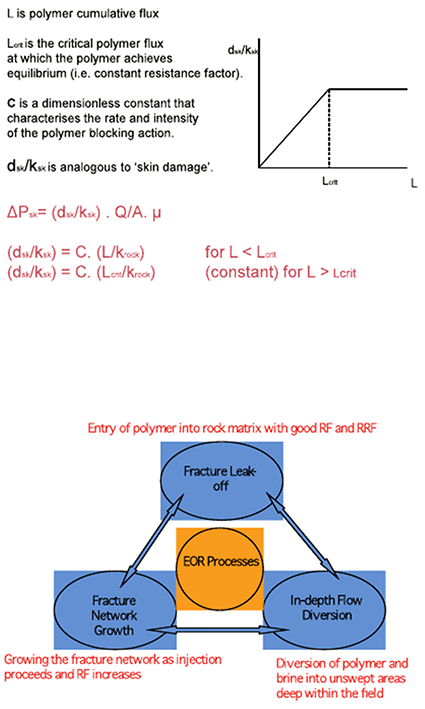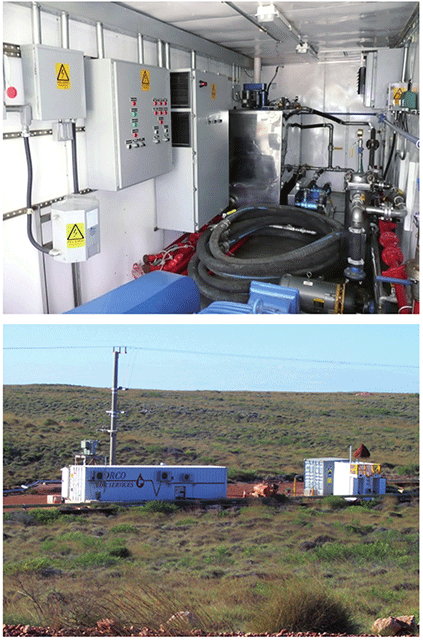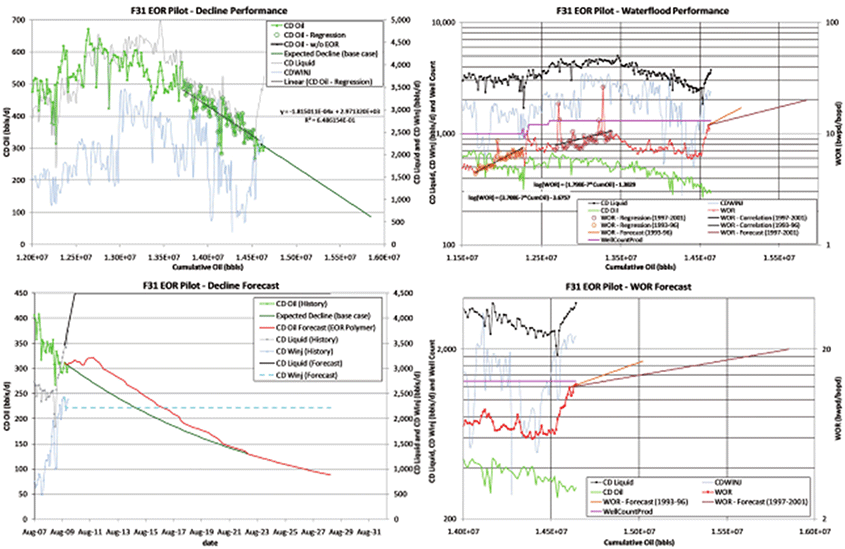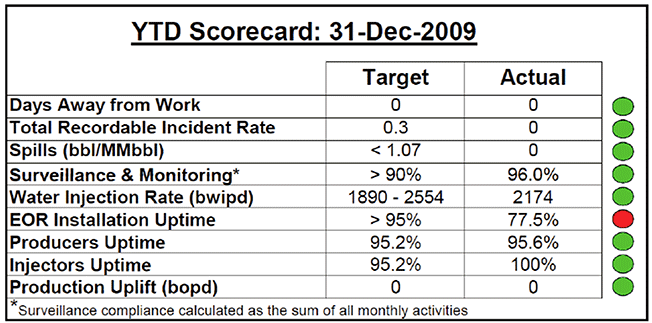The design and application of a polymer EOR trial on Barrow Island*
Wisnu Widjanarko A , Paul Philip Welton B , Daniel Eduardo León Echeverría C , Lina Hartanto D , John Benjamin Smith Scott E , Alistair James Parr Fletcher F and Paul Leicester Creagh Costelloe GThe APPEA Journal 50(2) 702-702 https://doi.org/10.1071/AJ09066
Published: 2010
Abstract
The design and application of a chemical EOR pilot for a complex, low-permeability waterflood will be presented. Our focus has been on developing appropriate field application options, allowing flexibility of operation against a background of reservoir complexity and uncertainty.
Australia’s Barrow Island Windalia reservoir, the nation’s largest onshore waterflood, was developed in the late 1960s. Cumulative oil production to date is over 288 MMSTBO.
Planning a chemical EOR scheme needs to address the following reservoir and production characteristics:
highly heterogeneous, very fine grained, bioturbated argillaceous sandstone, high in glauconite;
high porosity (0.28) but low permeability (5 mD with 20 mD+ streaks);
production and injection necessarily stimulated by induced fractures;
highly saline and hard brine; and,
large waterflood pattern volumes (10 MMbbl at 20 acre well spacing).
Initial screening recommended that polymers be considered for sweep improvement and conformance control, although reservoir complexity presented a challenge.
In this paper, we summarise the subsurface studies, and subsequent petroleum engineering and facilities design, which lead to the successful pilot start-up in May 2009. In particular, we discuss the implications on design and operation of a pilot in a Class A nature reserve. Results from the proposed polymer pilot flood will allow assessment of further chemical EOR applications and potential field-wide scale-up.
Keywords: Australia, Barrow Island, chemical EOR, EOR, field trial, fractured injectors, low permeability, monitoring and surveillance, polymers, waterflood
Introduction
This paper presents the design and application of a chemical enhanced oil recovery (EOR) trial for a complex, low-permeability reservoir under waterflood. The main focus has been on developing appropriate options for field application that allow flexibility of operation against a background of reservoir complexity and uncertainty.
Australia’s Barrow Island Windalia reservoir—the nation’s largest onshore waterflood—was developed in the late 1960s (Williams, 1977) and the cumulative oil production to date is in excess of 294 MMSTBO.
Planning for a chemical EOR scheme needs to address the following reservoir and production characteristics:
highly heterogeneous, very fine grained, bioturbated argillaceous sandstone, high in glauconite;
high porosity (0.28) but low permeability (5 mD with 20 mD+ streaks);
production and injection necessarily stimulated by induced fractures, with injection proceeding above the fracture gradient;
highly saline and hard brine; and,
large waterflood pattern volumes (10 MMSTBO at 20 acre well spacing).
Initial screening recommended that polymers be considered for sweep improvement and conformance control, although reservoir complexity presented a challenge.
The sub-surface studies are outlined here, together with the subsequent petroleum engineering and facilities design that lead to the successful pilot start-up in May 2009. Results from the trial polymer flood will allow assessment of further chemical EOR applications and potential field-wide expansion.
Subsurface and pilot design
Although water flooding has proceeded for over 40 years, characterisation of the field is considered difficult (Hatcher et al, 1996; Allard et al, 1999; Emanuel et al, 1993). The absence of good seismic reflectors associated with the Windalia reservoir has not assisted with its structural delineation. Logs typically show attenuated response for the Windalia and lead to difficulties in characterising production intervals. The difficulty of handling Windalia core material is one of the contributing factors to the petrophysical uncertainty of the reservoir.
Given the unusual nature of the field, screening for a viable EOR approach was a challenge. The shallow depth precludes miscible CO2 flooding and the low permeability and fractured injectors render immiscible CO2 flooding unfavourable.
Likewise, the low permeability and high clay content, together with the low viscosity high API gravity oil, make thermal EOR approaches unfavourable.
Analysis of the waterflood showed (Fletcher et al, 2008) water cycling as an immediate, key issue for the Windalia reservoir. If water cycling can be reduced and better sweep efficiency established, recovery techniques designed to mobilise residual oil can be implemented—such as surfactant and alkali/surfactant/polymer (ASP)—provided the issue of low permeability is addressed.
At the initial concept design phase, the Windalia field was deconstructed into those components that were beneficial, neutral or detrimental for polymer EOR. The key importance of the injection above formation fracture gradient for the past 40 years was then realised (Fletcher et al, 2008). The polymer EOR strategy was reconstructed with the fractures as the key component of the Windalia waterflood and EOR applications.

|
The approach to polymer EOR then took the induced fracture network and dynamic fracturing into account, with a methodology called in-depth flow diversion (IFD) developed.
In summary, in this approach:
polymer enters the rock matrix increasing resistance to fluid flow, but the injectivity is expected to be maintained;
as injection is above fracture gradient, the fracture is expected to grow as pressure increases due to the increased resistance within the rock matrix;
fracture behaviour depends on the polymer flux into the rock matrix and pressure behaviour in the fracture;
new unswept oil zones (both vertically and horizontally) are expected to be accessed by the growing fracture network and polymer as it enters the rock matrix;
the aim of IFD is to divert the flow of water deep within the reservoir; and,
the polymer acts to reduce leak-off into swept zones, allowing deeper diversion into unswept zones as the polymer flows by preference through the sealed fracture network.
This process is summarised in Fig. 1. With this design strategy in place, laboratory and coreflood studies were conducted to develop suitable chemical systems (Fletcher et al, 2008). Reservoir modelling was also initiated—although this proved to be a major challenge—and the simulation is still in progress using Petroleum Expert’s Reveal simulator.
Project execution
The purpose of the field trial is to prototype injection of polymer into select waterflood patterns on Barrow Island. The trial firstly aims to validate the reservoir response to polymer injection in terms of: oil uplift at associated producers; and, changes to water injectivity. Secondly, it aims to evaluate the requirements of polymer injection on Barrow Island in terms of surface facilities, personnel and resources.
The team’s vision of success for the trial is threefold, involving:
that surface facilities are successfully and safely deployed and the polymer is injected into the reservoir at the target concentration of 500 ppm for the proposed period of two years;
modification of reservoir response in terms of a quantifiable oil uplift attributable to polymer injection; and,
Polymer injection-related modification of waterflood trends as measured by changes in injectivity and reduction in water cycling.
The ability to simulate the polymer response is also envisaged by development of a predictive tool with the results from the trial being successfully matched to history using the reservoir model.
Primary and secondary patterns were selected. The surface area of the pilot is 247 acres with an effective thickness of 30 m and 10 MMSTB OIP. The reasons for selecting the patterns were: clear evidence of water cycling; a history of water injection to each pattern; and, a steady, interpretable rate of decline of oil production over the last decade, above which any incremental increase in oil production attributable to EOR can be measured. The patterns also had cleared surface areas which could be used for EOR equipment, thereby minimising the environmental footprint of the EOR pilot.

|
A modularised injection skid was leased for application on Barrow Island. The skid was re-fitted to Australian standards in Perth, quarantined and transported to Barrow Island, then installed and commissioned, as shown in Fig. 2.
Operation, surveillance and preliminary results
Since commissioning, the injection skid has been online over eight months with the greatest challenge being achievement of the uptime target (> 95%). Due to the foreign nature of the unit to the island, the uptime achieved by the end of 2009 was only 78%. As a result of this performance, a reliability review was conducted and it identified the need to intensify the maintenance schedule and increase the spare-parts inventory to minimise the loss of time after failures. Moreover, 85% of the downtime during 2009 was associated with five different events for which maintenance solutions have been identified and therefore are unlikely to reoccur.
The surveillance and monitoring plan has been successfully implemented with 96% compliance achieved during 2009.
The activities included:
14 offset producers being tested with a 30-day frequency or less to determine and quantify the oil production uplift and the reduction in water-oil-ratio (WRO);
water samples being collected from 14 producers and three injectors on a weekly basis followed by laboratory analysis that confirmed an average concentration of 440 ppm of polymer being injected and no polymer breakthrough at the producers;
pressure fall-off tests conducted at the injectors prior to start-up to be used as a baseline to track the fracture growth annually; and,
pressure build up tests scheduled for the producers every year to monitor the pressure performance.
In order to track the expected incremental oil production due to the polymer flood, an exponential decline curve was fitted to the production data for the period 2002–2009, which resulted in an average 6.5% annual decline rate for the combined offset producers of the pilot. This was extrapolated from October 2009 to set the baseline production and is presented on a Qo v Cum Oil plot in the top left chart of Fig. 3a. The bottom left chart of Fig. 3a includes the baseline decline compared to the expected incremental oil production rate, which shows a first response of 2 STBO/D in February 2010, with a peak incremental rate of 50 STBO/D in Q4-2011 and a total incremental rate of 116 MSTBO by 2020.
As an alternative method, the log10 WOR v Cum Oil was fitted with a linear trend in two different periods (1993–1996 and 1997–2001, which included three new infill wells) that correspond to different sweep scenarios. Both trends were extrapolated from October 2009 as an indication of past performance when the waterflood was at a sustained high-level and water cycling was evident. These are plotted of the top right chart of Fig. 3a.
The bottom right chart of Fig. 3a shows WOR still on a positive slope, but showing signs of plateauing since November 2009.
In summary, no early oil increase or WOR reduction has been observed so far, but at the same time no negative impact has been observed in the reservoir response since the pilot started. The expectation is that a production uplift will be observed during 2010 and conclusive results will be had by 2011. These will be documented and presented at the appropriate time. The pilot performance is tracked monthly and displayed on a dashboard that includes a YTD scorecard to measure the effectiveness of the project in terms of: safety; environmental impact; reliability; efficiency; surveillance; and incremental production. Fig. 3b shows the scorecard results for 2009.
References
Allard, D.N., Hillyer, M.G., Gerbacia, W.E., and Rychener, L.M., 1999—Empirical Risk Assessment of Infill Drilling Locations, Barrow Island, Australia. Society of Petroleum Engineers ATCE, Houston, 3–6 October. SPE 56816.Emanuel, A.S., Tang, R.W., McKay, D.M., and Ellis, M.H., 1993—A Hybrid Simulation Study of the Windalia Sand Waterflood. Society of Petroleum Engineers ATCE, Houston, 3–6 October. SPE 26477.
Fletcher, A.J.P., and Morrison, G.R., 2008—Developing a Chemical EOR Pilot Strategy for a Complex, Low Permeability Water Flood. Society of Petroleum Engineers, Improved Oil Recovery Symposium, Oklahoma, 19–23 April. SPE 112793.
Hatcher, G.B., Chen, H., Rahman, S.S., and Hogg, P.F., 1996—Evaluating Formation Damage Risks in a Glauconitic Sandstone Reservoir: A case History from the Offshore North West Shelf of Australia. Society of Petroleum Engineers, Asia Pacific Oil and Gas Conference, Adelaide, 28–31 October. SPE 37014.
Williams, C.T. (1977). An analysis of the production performance of the Windalia Sand Reservoir of the Barrow Island Oil Field. The APPEA Journal , 105–113.
* John Benjamin Smith Scott presented this extended abstract to the 50th APPEA Conference on Tuesday, 18 May in Brisbane.

Wisnu Widjanarko is the WA Oil Subsurface Development Team Leader with Chevron Australia and he joined Chevron in 2008. He has 20 years of experience in the reservoir engineering disciplines: including reservoir simulation; development planning; deserves; and, mature assets development. He has previously worked for ARCO, BP and Woodside in various locations worldwide. Wisnu has BSc in electrical engineering from Gadjah Mada University, Indonesia. |

Paul Welton has been the WA Oil Subsurface Manager since 2007 and is responsible for maximising recoveries from Barrow Island reservoirs. He has over 24 years’ experience with national and international E&P companies including: BP; Marathon; ADCO; BSP; Woodside; NAM; PDO; and Occidental in a range of petroleum engineering, production engineering, well engineering and operations roles. He has a BSc Hons in Petroleum Engineering from Imperial College, London. |

Daniel León has been involved in the EOR Windalia project since 2009, initially focussing on the surveillance and monitoring plan and after commissioning taking the role of Project Manager. He joined Chevron in 2006 as a reservoir engineer for the Gorgon Project and has been with the Barrow Island asset since 2008. |

Lina Hartanto has been the WA Oil Lead Reservoir Engineer since 2009 and is responsible for maximising and improving recoveries from Barrow Island reservoirs. She has over ten years’ experience with various oil and gas companies as a reservoir engineer at Woodside Energy Ltd and consultant at Roxar Pty Ltd in the range of reservoir engineering and reservoir characterisation. She has PhD and BEng (chemical engineering, Hons) from Curtin University of Technology, Perth. |

John Scott has been the project manager for the implementation of the Windalia EOR project since 2007. He headed up the multi-disciplinary team responsible for the reservoir surveillance and monitoring plans for the target wells and the installation and ongoing operation of the polymer injection equipment. John began his career in the oilfield with Schlumberger spending over 23 years filling various roles across the cementing, well testing, wireline, completions and integrated project management product lines, working in: Australia; Angola; China; Indonesia; Malaysia; Singapore; the UK; and Russia. He has been with Chevron since 2004 and holds qualifications in drilling engineering from Robert Gordon University, Aberdeen, UK. |

Alistair Fletcher has been an advisor to the Windalia EOR project since 2006. He has focussed on subsurface assessment, the laboratory and coreflood program, and design of the in-depth flow diversion (IFD) concept. Alistair began his career with BP as a reservoir engineer specialising in chemical EOR. He has also held positions with Curtin University of Technology, CSIRO Petroleum and the Petroleum Science and Technology Institute in the UK. |

Paul Costelloe has been the WA Oil Senior Facilities Engineer since 2005 and is responsible for mechanical equipment packages on Barrow Island. He has over 20 years’ experience in oil and gas production, petrochemical industries and original equipment manufacturers with companies such as: Saudi Aramco; SABICl; ExxonMobil; Shell; MK Kellogg; ABB Lummus; and Sulzer, covering a range of project engineering roles for mechanical packages and rotating equipment. He studied mechanical engineering at Coventry University, UK and also served with the British Armed Forces. |




